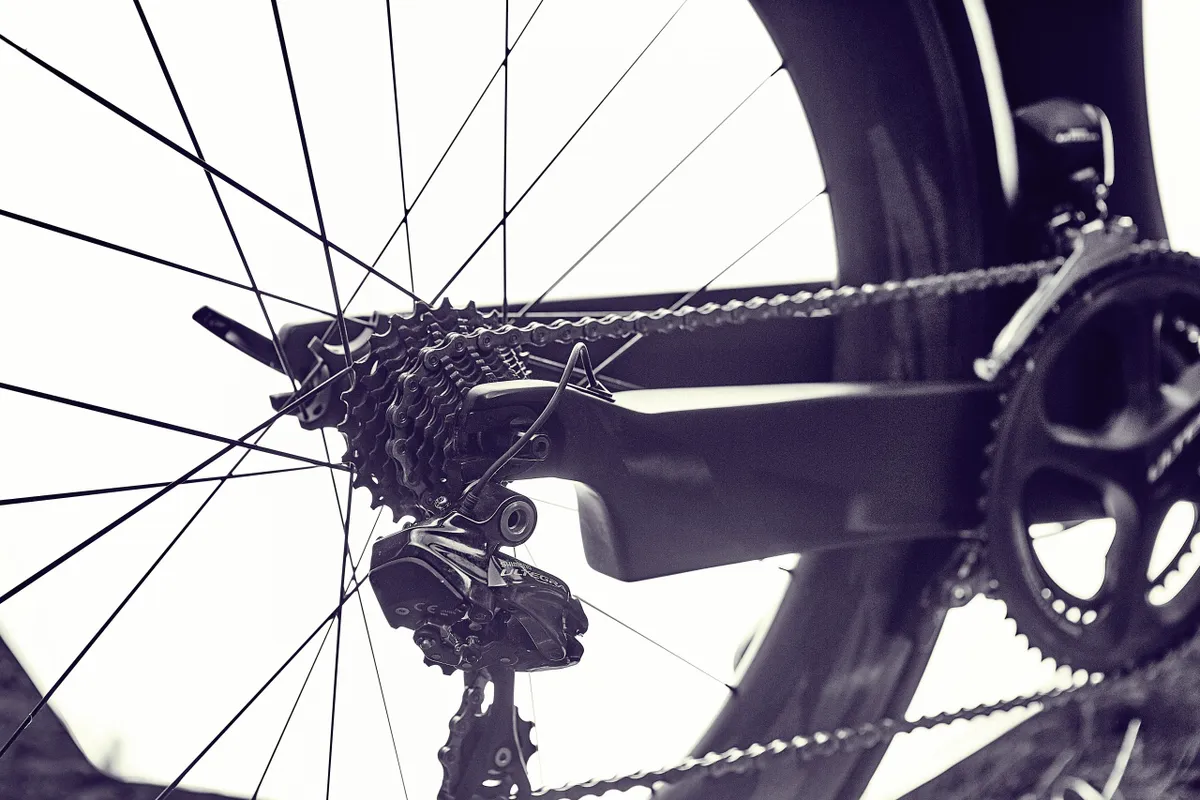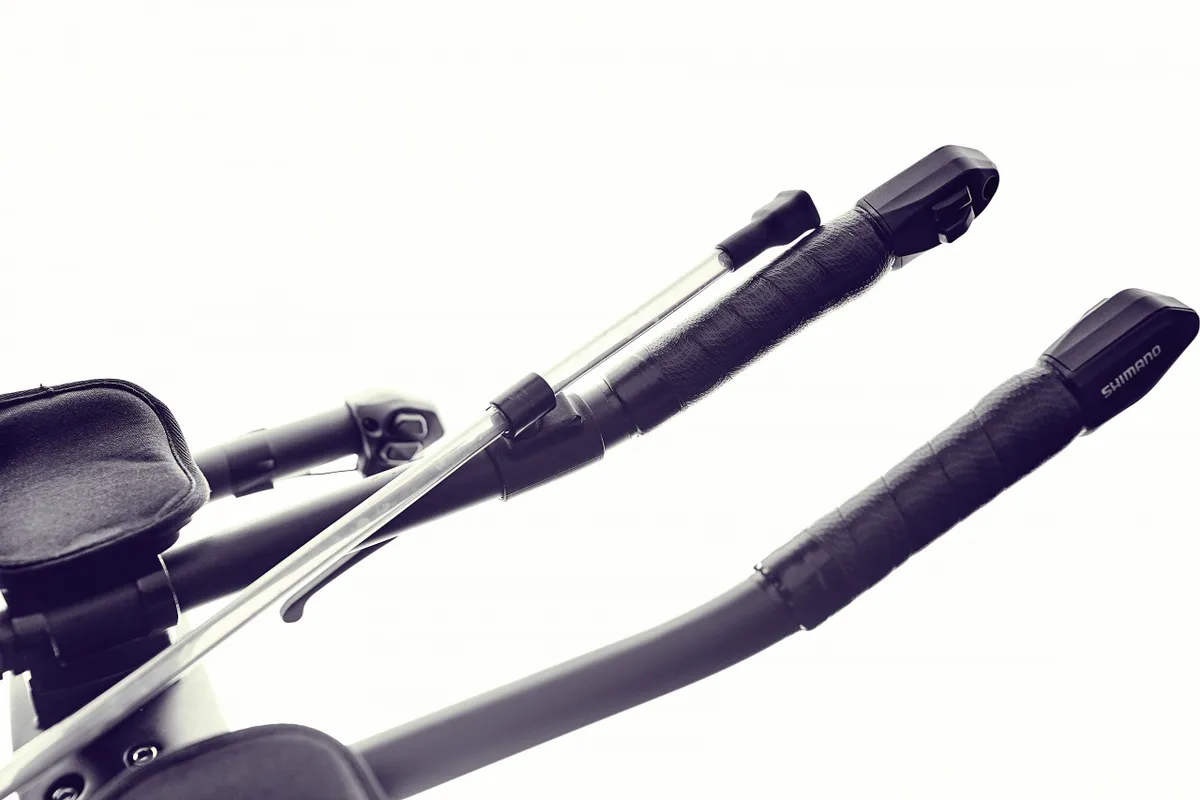Ventum One bike review
When you get to know the people behind this bike, you quickly realise that both its creation and extremity were entirely inevitable. James Seear, a pro triathlete and former ITU U23 world champ, and his dad, Peter, are both engineers with a passion for speed and for making fast things even faster. They have serious CVs, and even more serious friends.
“We’ve always designed and made things,” says James, “from classic cars to remote control planes, a 10-spoke carbon racing wheel and suspension for military off-road vehicles. When we decided to make a bike (late 2012) we began from our understanding of aerodynamics and structural design and consulted with the best aerodynamic engineers. From the earliest stages we employed CAD and CFD modelling. We’re very engineering focussed and the bike’s form is all engineering rather than styling. My athlete background also aided in making sure the bike was nice to ride and easy to travel with. We had input from some close friends, who unfortunately cannot be named. They’re ex-air force but are specialists in aero and carbon structural design.”
After a year of research and development, including cutting up several top brand frames to study them and “playing with a number of interesting designs”, the team settled on this radical ‘Z-frame’ and took a rough prototype to a wind tunnel, where the project leapt forward.
“The first test showed phenomenal results,” says James. “The wind tunnel technician ended up re-running tests because he thought the instrumentation was playing up. In fact, our bike was so much faster than anything they’d seen.”
The removal of the down tube addresses the most serious inconsistency between a wind tunnel and the road: the angle of the front wheel. In a tunnel the front wheel is clamped in place whereas on the road you make continuous tiny adjustments which means that the airflow from the front wheel to the down tube, the single most critical transition, is inconsistent. Modern UCI-legal frames have addressed this by moving away from skinny, wheel-hugging, super-fast-in-the-tunnel, cut-out down tubes to broader and straighter designs, but are constrained to a double-diamond frame by the UCI rules.
With only triathlon in mind, Ventum ditched the down tube altogether, removing the air transition and also that tube’s own drag. “The higher the wind speed or the larger the yaw angle the bigger the advantage our design has over frames with down tubes,” adds James. The seatstays were just two more tubes in the wind, and also a hotspot where forward rotating spokes meet rearward airflow in a tight space, so they went, too.
Neither is an entirely new idea – Diamond, Falco and, further back, Zipp, Softride and Lotus all designed aero bikes with incomplete triangles – but Ventum claim they have taken the concept further and built a bike to beat all-comers, particularly thanks to the integrated hydration tank on the frame. In their tests against a Cervélo P5, Scott Plasma 5 and Canyon Speedmax, the One was fastest by a slender 15g of drag against a P5 with no hydration, but by 117g (24%) over a P5 with two bottles. That’s a rather mean test as it’s the least aero drinks set-up but, by contrast, the One is actually faster with its 1.4L tank in place and no other bottle design can claim that.
The frame itself is a true monocoque, made from top-grade Toray T800, T1000 and T1200 carbon fibre. Seear told us that, in the end, no compromise was required between aerodynamic performance and ride quality: “The handling is just as important as the speed and we tested many ideas in the tunnel and on the road. Our smooth frame shell is both [stiff] and aero.”
The build
The Ventum One is available direct from the US as a frameset for $6,250, or built with Shimano Ultegra Di2 and Zipp 60s for $8,500, or with Dura-Ace Di2 and Zipp 808s for $11,500. Our test bike is the Ultegra version but it didn’t come with wheels so we dropped in a set of Zipp 808 NSWs. The rear only just clears the chainstays; certain discs and wheels won’t fit so check before buying.
The integrated cockpit offers 60mm of vertical arm-pad adjustment. It has a conventional steerer clamp so it can be easily replaced and adjusted for height. The fork cover has to be cut to the bar height but a spare cover is, surprisingly, only $30.
Fitting the cover is tricky as it’s a very tight fit, especially with the TRP V-brake opened out for wide aero rims. We also had an issue with the dual-mount rear brake on our test bike – it fouled the 4iiii power meter we tried to fit (and would with Stages and Pioneer, too). Ventum now offer a Pioneer as an option and have changed the rear brake to a TRP T851.
into the unknown
Before riding it, we wondered if the Ventum, devoid of 40% of a conventional frame, might usurp the Blue Triad SL of a few years ago as the most flexy thing we’ve ever ridden, but within a hundred metres it was clear that it wouldn’t. In fact, the One initially feels normal, and nothing like it looks. The steering is neutral and accurate, it’s stable, and the power transfer is far more robust than you’d ever imagine from staring at the BB shell, hanging down like a pendulum. What’s more, despite all the reinforcing that must have been necessary with three tubes removed, the One is impressively compliant.
With more time in the saddle, some idiosyncrasies began to appear and as testers it proved fascinating, sending back sensations that we’ve never had from any other bike. For instance, while the fork is stiff and transmits your input from the bar to the front axle in high-fidelity, the top tube has occasional wobbles, breaks down in tears and plays Adele songs for the down tube it misses. Crosswind gusts and bumps can produce a shimmy and it lacks some precision on descents.
A similarly unusual combination of behaviours takes place at the rear end. Apply some power and the huge chainstays deliver it like UPS, with impressive lateral rigidity, but get out of the saddle and apply a lot of power and the One is undone by its other USP. Without seatstays to brace it, the rear axle is able to twist as you lean the bike, producing audible brake rub. At least we thought it was brake rub. When we removed the wheel to check, it turned out that the tyre and the rim had been rubbing the chainstay, that narrow clearance obviously too tight. A $6,250 frame and a $1,900 rear wheel wearing each other to dust… We asked Ventum and they said to check the wheel is straight (it was) and that otherwise the Zipps are to blame for not being stiff enough. We suggest sticking to a narrower rim, say 24mm, than the 808’s 28mm.
With this tester’s 80.5cm saddle height, it wasn’t possible to get the nose within 3cm of the BB. The sliding saddle clamp offers a range of seat-tube angles but the 79º maximum isn’t especially steep by tri standards. It’s the main threat to your running legs if you can’t get your position; otherwise the Ventum’s smoothness and easy drink access should leave you feeling good.
How fast?
To find out if the radical design pays off, we threw the Ventum into a timed test against one of our favourite tri bikes of the year, the Orbea Ordu Ltd. We used our usual quiet 10-mile club TT course, wore the same kit and swapped across the Zipp 808s. The Orbea was fitted with a 700ml bottle behind the saddle. We rode to exactly 301W on each bike, and did the two runs within an hour in equal conditions. The Orbea posted 23:13, the Ventum 23:20, and was nudged around a bit more in the crosswinds, too. We then repeated the test on the smooth Castle Combe circuit at 320W. This time the Orbea ran 21:46 and the Ventum 22:10, a significant difference. Ventum suggested that optimising our position for the One in a wind tunnel should improve the result. What our test didn’t include was drinking and on the One you can access 1.4L without breaking position, which will certainly close the gap on long rides.
The Ventum is good but it hasn’t blown us, or a key rival, away as promised. However, this is only the start of the brand’s journey. We know how these guys love to make fast things faster.
Ventum One Verdict
Handling 78%
Absent down tube leaves top tube overworked; a bit heavy
Spec 88%
Includes drink system and Zipps, power meter optional
Value 80%
The expensive frame makes the complete bike costly
Comfort 94%
Unique frame smothers bumps much better than most




